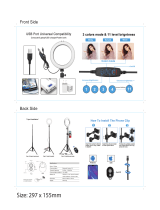
2
Table of Content
Table of Content ................................................................................................................................... 2
1. SmarStar
®
Cube
TM
-II Series Overview .............................................................................................. 4
1.1. SmartStar
®
Cube
TM
-II Mount ...................................................................................................... 4
1.2. Assembly Terms ......................................................................................................................... 5
1.3. Go2Nova
®
8408 Hand Controller ............................................................................................... 5
1.3.1. Key Description .................................................................................................................... 6
1.3.2. The LCD Screen .................................................................................................................. 6
1.4. Check the Battery ....................................................................................................................... 7
2. Cube-II Mount Assembly ................................................................................................................... 8
2.1. Setup a Mount in AA Mode ......................................................................................................... 8
2.2. Setup a Mount in EQ Mode ...................................................................................................... 12
3. Get Started ...................................................................................................................................... 15
3.1. Setup the Mount ....................................................................................................................... 15
3.2. Get Familiar with Telescope ..................................................................................................... 15
3.2.1. Assemble the Telescope .................................................................................................... 15
3.2.2. Using the telescope ........................................................................................................... 16
3.3. Moving the telescope................................................................................................................ 16
3.4. Initial Star Alignment................................................................................................................. 17
3.5. Go to the Moon and Other Stars .............................................................................................. 17
3.6. Star Identifying Function ........................................................................................................... 17
3.7. GOTO and Tracking Position Memorization ............................................................................. 17
3.8. Turn Off the Mount ................................................................................................................... 18
4. Complete Functions of Go2Nova
®
8408 Hand Controller ............................................................... 19
4.1. Slew to an Object ..................................................................................................................... 19
4.1.1. Solar System ..................................................................................................................... 19
4.1.2. Deep Sky Objects .............................................................................................................. 19
4.1.3. Stars: ................................................................................................................................. 19
4.1.4. Comets .............................................................................................................................. 19
4.1.5. Asteroids ............................................................................................................................ 19
4.1.6. Constellations .................................................................................................................... 19
4.1.7. Custom Objects ................................................................................................................. 19
4.1.8. Custom R.A. and DEC ....................................................................................................... 19
4.2. Sync to Target .......................................................................................................................... 20
4.3. Alignment ................................................................................................................................. 20
4.3.1. Pole Star Position (Only for EQ Mode) .............................................................................. 20
4.3.2. One Star Alignment ............................................................................................................ 20
4.3.3. Two Star Alignment ............................................................................................................ 20
4.3.4. Three Star Align ................................................................................................................. 20
4.3.5. Polar Iterate Align (Only for EQ Mode) .............................................................................. 21
4.3.6. Solar System Align ............................................................................................................. 21
4.3.7. Display Model Error ........................................................................................................... 21
4.3.8. Clear Alignment Data ......................................................................................................... 21
4.4. Set tings ................................................................................................................................... 21
4.4.1. Set Time and Site .............................................................................................................. 21
4.4.2. Set Beep ............................................................................................................................ 21
4.4.3. Set Display ......................................................................................................................... 22
4.4.4. Set Tracking Rate .............................................................................................................. 22
4.4.5. Set Altitude Limit ................................................................................................................ 22




















